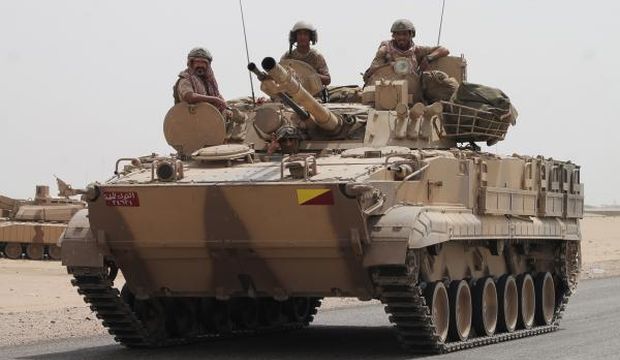
Soldiers stand on a tank of the Saudi-led coalition deployed on the outskirts of the southern Yemeni port city of Aden, on August 3, 2015. (AFP Photo/Saleh Al-Obeidi)
Sana’a, Asharq Al-Awsat—Ground troops from the United Arab Emirates have landed in the central Yemeni province of Ma’rib to support forces loyal to Yemen’s government in their fight against the Iran-backed Houthi insurgents, sources say.
Speaking to Asharq Al-Awsat, Brig. Gen. Ahmed Asiri, the spokesman for the Saudi-led coalition targeting the Houthis in Yemen, which includes the UAE, confirmed that Emirati forces have arrived in the central oil-rich province.
“What is happening in Ma’rib is an on-the-ground operation to support Yemeni forces comprising the Popular Resistance [a coalition of volunteer forces loyal to the government] and the Yemeni army,” Asiri said.
“They are being supported by air cover [from the coalition] as well as information and experts on the ground,” he added.
Informed Yemeni sources said the Emirati troops had entered Yemen on Friday via the Wadia border crossing which links Yemen to northern neighbor Saudi Arabia. They said the operation comes as part of “a new phase” for the coalition’s anti-Houthi campaign, comprising “direct intervention in a number of fronts.”
This follows several victories for forces loyal to Yemen’s internationally recognized President Abd Rabbuh Mansur Hadi and the government, mostly taking place in the country’s south.
Government loyalists last month captured the southern port city of Aden from the Houthis. Several members of the Yemeni cabinet have now returned to the city after months in exile following the Houthi coup in February and forces from the coalition been landing at the city’s airport.
The Popular Resistance say they are now heading northwards to the capital Sana’a, which the Houthis captured in September 2014. The Houthis declared a state of emergency in Sana’a on August 9 in anticipation of an impending operation by the Popular Resistance to retake the capital.
A state of emergency was also declared a week later in the northern Houthi stronghold of Saada. There have been reports that communications networks, including telephone and Internet lines, have now been cut in some parts of the province.
Other reports from Saada, circulating since early on Saturday, say Houthi leader Abdul Malik Al-Houthi has been injured in clashes between the Houthi rebels and the Popular Resistance—but these reports remain as yet unconfirmed.
Meanwhile, Ahmed Mahdi Fadheel, the new governor of the southern Lahj province, which was recently liberated from the Houthis by pro-government forces, told Asharq Al-Awsat the coalition had concentrated initially on the country’s southern regions in order to protect the Bab El-Mandeb strait.
He said the Houthis have been seeking to gain control of southern regions in Yemen in order to control the strategic waterway for ally Iran.
On Sunday Yemeni sources close to the government told the Associated Press the Saudi-led coalition has started bombing Houthi positions near Bab El-Mandeb in preparation for a ground operation to secure the strait.
The Bab El-Mandeb strait lies between Yemen and the Horn of Africa and connects the Indian Ocean and the Mediterranean via the Red Sea and the Suez Canal. It is one of the most important maritime corridors in the world, through which most of Yemen and the Gulf states’ oil exports pass on their way to global markets.
